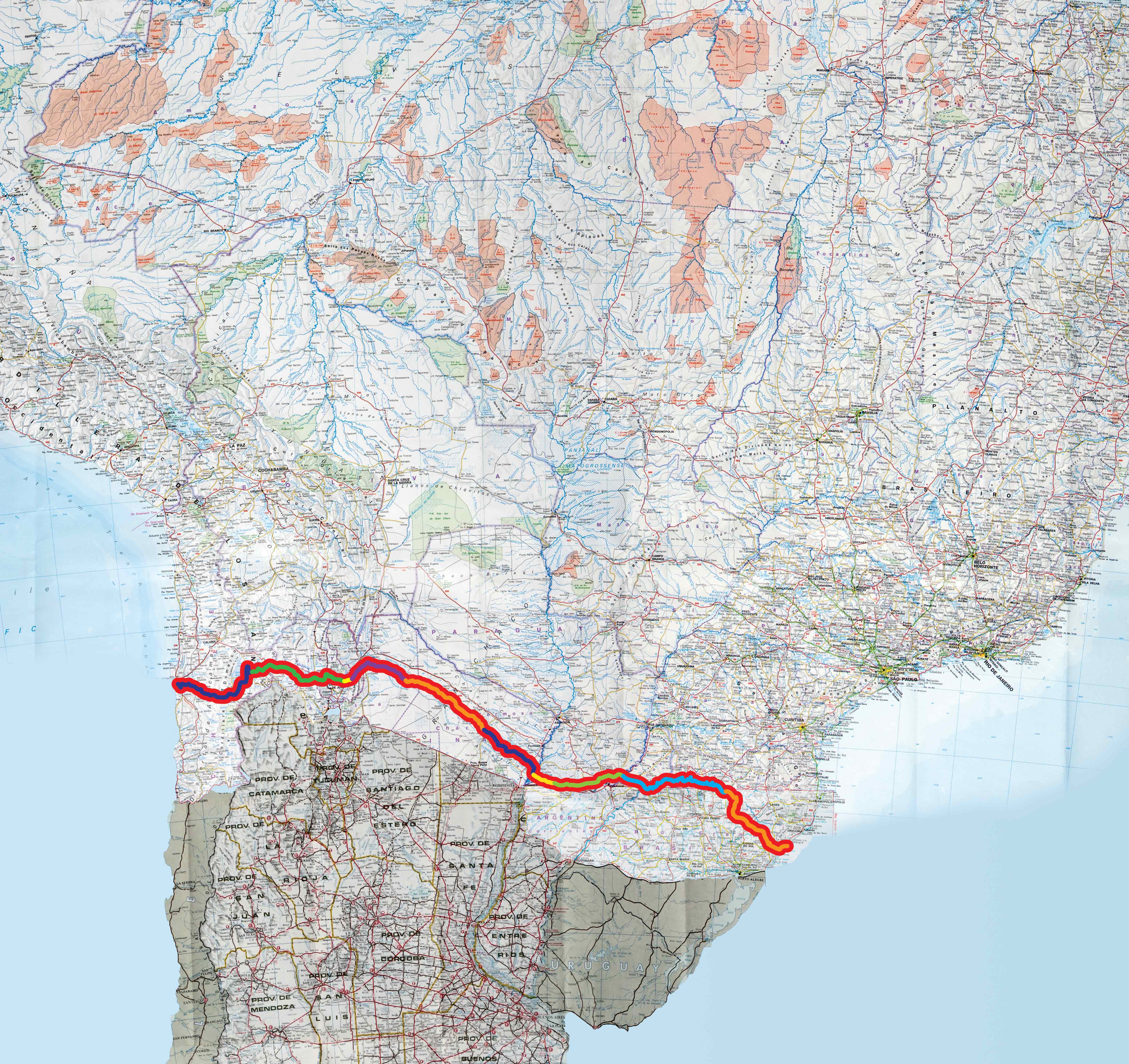Walk/Raft Across South America

The route of Jeff Shea’s walk and raft across South America:
In 2020, I completed walking and rafting across the entire width of the continent of South America along the route shown in the illustration above.
This route took me across the Atacama (the driest desert in the world), the South American Altiplano (the second highest highland plateau in the world) and along the tributaries of the second largest river system in South America (the Río de la Plata).
These biomes, and some of the species contained within them, are described below.
I am preparing to return in Fall 2021/Spring 2022 to do research with the aim of proposing a wildlife corridor across South America along this route.
The Atacama
The Atacama Desert is one of the driest regions in the world due to distinct weather patterns and is ecologically important due to its high plant diversity, low levels of human encroachment and harsh climatic conditions. Species that live here are found nowhere else on the planet and have adapted to the extremely difficult natural conditions. For instance, over 550 species of plants with a high level of endemism can be found here.[1] Examples of these species include Eulychnia iquiquensis (Copao)[2], Ephedra breana (Sea grape)[3] and Nolana tocopillensis[4]. Additionally, a variety of fauna are endemic to the Atacama Desert such as Pseudalopex griseus (South American gray fox)[5], Phoenicopterus chilensis(Chilean flamingo)[6] and Upucerthia albigula (White-throated Earthcreeper)[7].
The South American Altiplano
To the east of the Atacama Desert, the Altiplano rises to an elevation over 3,600 meters above sea level and is the second largest high plateau in the world after Tibet.[8] Similar to the Atacama Desert, the Altiplano is fairly inhospitable and the species here are highly adapted to the rough environment. There are over 50 ‘salars,’ or wet salt lakes, in this region. Some of these salt lakes are over 100 kilometers in diameter.[9] Examples of plants and animals found here include Vicugna vicugna (vicuna)[10], Lama glama (llama)[11], Felis concolor (puma)[12], Vultur gryphus (Andean condor)[13], Festuca orthophylla (hiro grass)[14] and Histiotus montanus (Small big-eared brown bat).[15] There are also many endemic species such as Rhea pennata (Lesser Rhea)[16], Cinclodes aricomae (Royal cinclodes)[17], Chalcostima olivaceum (Olivaceous thornbill)[18] and Diglosa carbonaria (Gray-bellied flowerpiercer).[19]
The Río de la Plata Watershed
Roughly two thirds of this route lies within the drainage watershed of the Río de la Plata, one of the largest drainage basins in the world.[20] The Bermejo River has a high level of biodiversity and sediment discharge, with its upper river basin being the most biodiverse region in all of Argentina.[21] Flowing over 1,000 kilometers, the Bermejo River is known for its high levels of reddish sediment and meandering nature.[22],[23] Charismatic species present in the Bermejo River basin and Paraguay River include Bathytoshia brevicaudata (Short-tailed river stingray)[24], Ajaia ajaja (Roseate spoonbill)[25], Nasua nasua (South American coati)[26], Ceiba chodatii (floss silk tree)[27], Rhea americana (Great Rhea)[28] and Clelia clelia (Black Mussurana).[29]
With dramatic cliffs in the Atlantic Forest (an area characterized by high biodiversity and endemism)[30] less than 50 kilometers from the Atlantic Ocean, this expedition terminated on the coast of Brazil. Just over one quarter of the Atlantic Forest remains in its native vegetative state but still shows the power of this ecosystem. With 40% of the plants and 60% of the vertebrates in this area found nowhere else on the planet, this expedition will bring attention to this important region as well as all the other areas beginning at the Pacific Ocean. The Atlantic Forest is home to 8,000 endemic plant species, over 100 endemic bird species, 70 endemic mammal species, 95 endemic reptile species, over 200 endemic amphibian species and over 130 endemic freshwater fish species.[31]
There are many species of flora impacted by human activities such as Baccharis genistelloides (carqueja),[32], Aristida pallens (Goat’s Beard or “barba de bode”)[33], Senecio brasiliensis (Maria-mole or Flower of souls)[34], Achyrocline satureioides (Macela),[35] Cedrela angustifolia (Cedro)[36], Schinus terebinthifolia (Aroeira)[37], Eugenia stipitata(Araza)[38], Araucaria angustifolia (pinheiro or Paraná pine)[39], Cordia salicifolia (Cha De Bugre)[40], Dicksonia sellowiana (xaxim)[41], trees in the Myrtaceae family (Guamirim)[42], Bromelia argentina (Caraguata)[43], Scutia buxifolia (Coronilho)[44] and Piper auritum (Mexican pepperleaf or yerba santa).[45] Additionally, species such as Furnarius rufus (red ovenbird or rufous hornero)[46], Polypodium decumanum (Samambaia)[47], Isoptera (cupim or termite),[48] Aratinga auricapillus (Golden-capped Parakeet)[49], Psidium amplexicaule (Goiba de serra or mountain guava)[50] and Rollinia sylvatica (Ariticum)[51] can be found in this region. Examples of endemic species and/or charismatic fauna include Paratecoma peroba (Peroba)[52], Amazona brasiliensis (Red-tailed Amazon)[53], Eretmochelys imbricata (Hawksbill sea turtle)[54] and Brachycephalidae (Robber frogs).[55]
[1] https://www.worldwildlife.org/ecoregions/nt1303
[2] http://www.llifle.com/Encyclopedia/CACTI/Family/Cactaceae/8188/Eulychnia_iquiquensis
[3] http://www.chileflora.com/Florachilena/FloraEnglish/HighResPages/EH0718.htm
[4] https://www.gbif.org/species/3797179
[5] https://www.iucnredlist.org/species/6927/111975602
[6] https://www.gochile.cl/en/flora-fauna/flamingo.htm
[7] https://www.hbw.com/species/white-throated-earthcreeper-upucerthia-albigula
[8] https://www.britannica.com/place/Altiplano
[9] https://www.southamericatotheworld.com/salars-of-the-andes/
[10] https://www.britannica.com/animal/vicuna
[11] https://www.nationalgeographic.com/animals/mammals/l/llama/
[12] https://www.discoverlife.org/nh/tx/Vertebrata/Mammalia/Felidae/Puma/concolor/
[13] https://www.iucnredlist.org/species/22697641/117360971
[14] http://legacy.tropicos.org/Name/25513295
[15] https://www.inaturalist.org/taxa/40534-Histiotus-montanus
[16] https://www.domesticforest.com/lesser-rhea/
[17] http://datazone.birdlife.org/species/factsheet/royal-cinclodes-cinclodes-aricomae
[18] http://datazone.birdlife.org/species/factsheet/22688027
[19] https://avibase.bsc-eoc.org/species.jsp?avibaseid=2D4F59B1659D3A08
[20] https://en.wikipedia.org/wiki/R%C3%ADo_de_la_Plata
[21] Alfredo Grau and Alejandro Diego Brown “Development Threats to Biodiversity and Opportunities for Conservation in the Mountain Ranges of the Upper Bermejo River Basin, NW Argentina and SW Bolivia,” AMBIO: A Journal of the Human Environment 29(7), 445-450, (1 November 2000). https://doi.org/10.1579/0044-7447-29.7.445
[22] https://www.britannica.com/place/Bermejo-River
[23] https://earthobservatory.nasa.gov/images/146168/bermejo-river
[24] https://www.fishbase.se/Summary/SpeciesSummary.php?ID=53772&AT=Raja
[25] https://animaldiversity.org/accounts/Ajaia_ajaja/
[26] https://www.cabi.org/isc/datasheet/74001
[27] https://paraguay.wcs.org/en-us/Wildlife/Bottle-tree.aspx
[28] https://birdsoftheworld.org/bow/species/grerhe1/cur/introduction
[29] http://reptile-database.reptarium.cz/species?genus=Clelia&species=clelia
[30] https://en.wikipedia.org/wiki/Atlantic_Forest
[31] https://www.cepf.net/our-work/biodiversity-hotspots/atlantic-forest/species
[32] https://pfaf.org/user/Plant.aspx?LatinName=Baccharis+genistelloides
[33] http://powo.science.kew.org/taxon/urn:lsid:ipni.org:names:19274-2
[34] https://www.discoverlife.org/mp/20q?search=Senecio+brasiliensis
[35] https://en.wikipedia.org/wiki/Achyrocline_satureioides
[36] https://www.gbif.org/species/3851194
[37]https://www.ipef.br/identificacao/nativas/detalhes.asp?codigo=30
[38] http://tropical.theferns.info/viewtropical.php?id=Eugenia+stipitata
[39] https://www.conifers.org/ar/Araucaria_angustifolia.php
[40] http://legacy.tropicos.org/Name/4000749
[41] https://npgsweb.ars-grin.gov/gringlobal/taxonomydetail.aspx?id=13923
[42] https://journals.sagepub.com/doi/10.1177/194008291600900115
[43]https://www.agron.com.br/publicacoes/noticias/ecologia-agro-sustentavel/2014/05/20/039480/caraguata-comum—bromelia-pinguin.html
[44] https://www.beneficiosdasplantas.com.br/coronilha/
[45] https://www.cabi.org/isc/datasheet/41359
[46] https://www.bdc.ib.unicamp.br/bdc/visualizarMaterial.php?idMaterial=381#.XotzhBnYo3F
[47] http://www.rain-tree.com/samambia.htm
[48] https://www.cell.com/current-biology/fulltext/S0960-9822(18)31287-9
[49] https://www.iucnredlist.org/species/22685710/93084117
[50] https://www.ipni.org/n/600710-1
[51] http://arvores.brasil.nom.br/new/pinha/index.htm
[52] http://tropical.theferns.info/viewtropical.php?id=Paratecoma+peroba
[53] https://birdsoftheworld.org/bow/species/retpar1/cur/introduction
[54] http://reptile-database.reptarium.cz/species?genus=Eretmochelys&species=imbricata
[55] https://amphibiaweb.org/lists/Brachycephalidae.shtml
